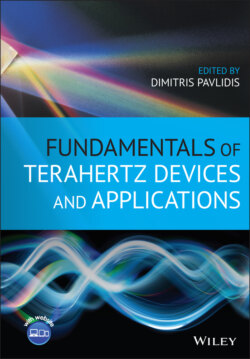Читать книгу Fundamentals of Terahertz Devices and Applications - Группа авторов - Страница 24
2.3.1 Radiation of Extended Semi‐hemispherical Lenses
ОглавлениеIn Section 2.2, we computed the radiation pattern from an elliptical lens antenna by deriving the currents on a planar aperture above the lens and, from them, we obtained the radiated fields from the lens antenna. In this section, we will explain how to compute the radiated fields of the extended hemispherical lens antenna from the currents evaluated on the lens surface. A PO method provides an approximation of these surface currents over a lens of several wavelengths. Using again the Love's Equivalence Principle, the radiated fields from the antenna feed obtained previously are used to compute the equivalent magnetic and electric sheet currents outside of the lens surface:
(2.60)
(2.61)
where is the normal vector to the surface of the lens (Figure 2.10) and and are the radiated fields from the antenna feed transferred outside the boundary of the lens. The transmitted fields can be calculated similarly that how it was done for the elliptical lens. The PO assumes that the equivalent currents can be formulated directly using the transmitted fields. Those are computed by approximating the lens surface locally by a flat dielectric‐air interface and using the Fresnel transmission coefficients for plane waves as explained previously. Thus, the radiated field from the feed is decomposed into their parallel and perpendicular components to the incidence plane (see Figure 2.10) and multiplied by the corresponding transmission coefficient. The total field is defined by , and the total magnetic field can be equivalently calculated as . Each of the components is given by:
Figure 2.10 Sketch of the extended semi‐hemispherical lens antenna parameters.
(2.62)
(2.63)
where the τ‖ and τ⊥ are Fresnel transmission coefficients for a dielectric lens of permittivity εr (2.27 and 2.28). This time the incident angle is evaluated using the normal vector corresponding to the hemispherical lens. The propagation vectors of the incident and transmitted fields are defined as follows:
(2.64)
(2.65)
(2.66)
Once the PO surface currents are evaluated via the transmitted fields, one can obtain the far‐field patterns. Those patterns can be obtained using the reference system shown in Figure 2.8, and integrating the PO surface currents over the lens hemispherical surface, as follows:
(2.67)
(2.68)
Figure 2.11 Directivity of an elliptical lens and an extended hemispherical lens as a function of the feed illumination. A feed illumination of a f(θ) = cosnθ is used in the example to illuminate a silicon lens of diameter 7.65 λ and an extended hemispherical lens of L = 0.375.
where R is the radius of the hemisphere of the lens,, η. The equivalent magnetic and electric currents are defined as , .
Figure 2.11 shows the directivity of a silicon elliptical lens and a hemispherical lens (i.e. synthesized from the elliptic geometry) as a function of the subtended angle by the feed. As it is shown in the figure, the elliptical lens provides the highest directivity compared to the hemispherical lens, however, the difference is only noticeable when using a feed with low directivity (low n). As the directivity increases, the performance of the elliptical and extended semi‐hemispherical is equivalent.
